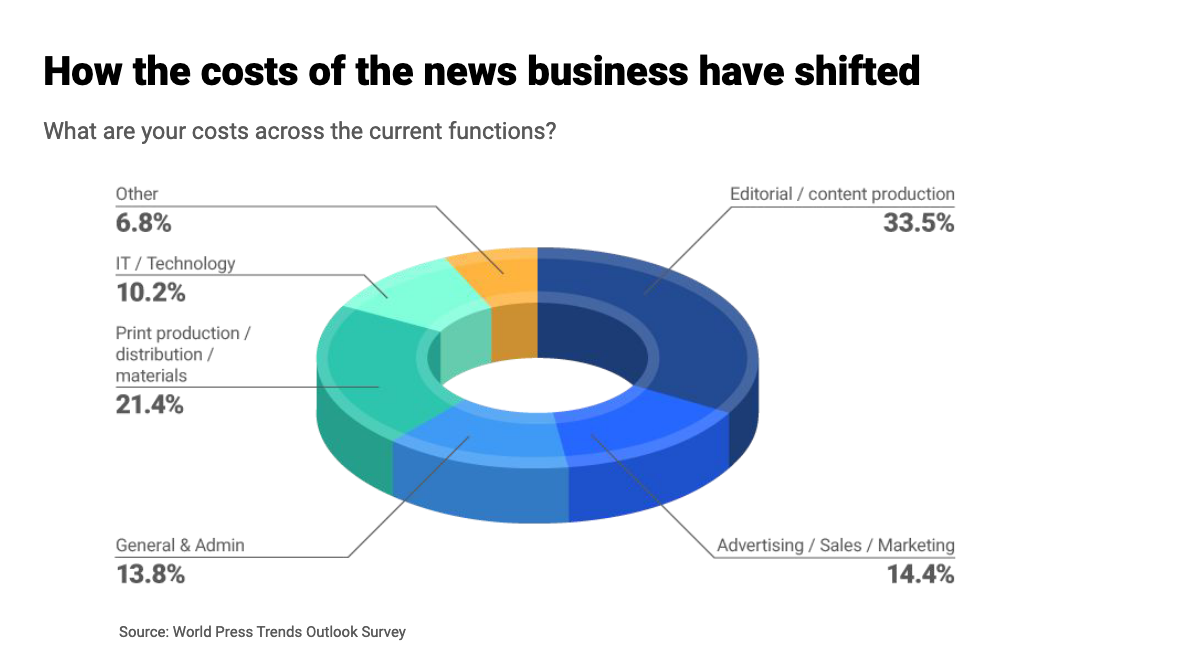Members can download the World Press Trends Outlook report for free here; non-members interested in purchasing the report can contact: customerservice@wan-ifra.org).
The costs of the news business have shifted during recent years as publishers have been adopting digital transformation as a core strategy.
A third of costs now coming from editorial
Twenty or even ten years ago, nearly 50 percent of publishers’ costs came from print production, (particularly with newsprint), and distribution. This has since dropped to 21.4 percent.
Instead, editorial and content production now make up a third of total costs. And while editorial making up the majority of investment is encouraging to see, the figure is actually lower than what typically accounted for the costs of producing news ten or twenty years ago when it stood at around 35 percent.

Much of that is due to the drastic cuts newsrooms have experienced in regions such as the US or the UK, for example, during the past decade (and more so recently).
But it is also due to the increased investment in tech (data, product development) that works hand in hand with editorial and is often embedded in newsrooms, and has gained importance as publishers increasingly adopt reader revenue and audience-first strategies.
Digital transformation and print innovation at Canada’s Globe and Mail
However, as with every finding in World Press Trends, the market situation, regional factors, company culture, and strategic focus can, naturally, vary widely. Take the Globe and Mail in Canada. The company has been bullish on digital transformation for years now, but also innovating in print. Its cost structure reflects that.
“Our printing, newsprint and distribution bill is 38 percent of total costs, and that’s significantly less than five years ago, when we made a determined drive to eliminate unprofitable delivery routes and make sure that we weren’t losing money on print,” said Globe and Mail CEO Phillip Crawley.
“Our distribution costs as a national newspaper in a very large country with only 36 million people are probably higher than most. The other big difference is that our Editorial costs are only 20% of the total. That doesn’t count custom content which is a growing source of revenue, and is run out of Advertising. We have held the Editorial budget, for staff and freelance, at about the same level for the last several years. We have about 220 full time journalists. Twenty years ago that would have been 300-plus.
“Otherwise our costs are similar to your chart, although our expanding workforce supporting data science and digital, including our Sophi analytics and automation products, means that category of expense is rising each year.”
Here are some other key findings from the report (members can download the report for free here; non-members interested in purchasing the report can contact: customerservice@wan-ifra.org):
Outlook
- 44% of respondents said accelerating their digital transformation strategy was the most important change they needed to make moving forward.
- “Digital transformation” is an overarching strategy for most companies but the specifics of that are increasingly audiences-first, reader revenue, data and product dev. It is no coincidence that the three next most important changes for 2021 mirror those of top investment plans: accelerating reader revenue plans, the same for data analytics, and more tech investment.
- News executives don’t consider the short-term impact of the pandemic as the biggest risk to their organisation’s future success. Instead, the respondents to our survey say their organisation’s greatest threats are the ongoing decline of news publishers’ share of the advertising market, 30.6%, (in which the pandemic plays a key role naturally) and their organisation’s inability to diversify revenues (21%).
2020 results and pandemic
- 43% of respondents from our WPT Publishers Outlook survey said their revenues declined by more than 20% “in the last 12 months”; another 7% said theirs declined by more than 10%.
- On average, overall revenue was down by 11%, publishers reported.
- However, 17% of publishers reported an increase in revenues last year, according to our Outlook survey, with 11% actually saying revenues were up more than 20%.
- Digital circulation revenue has been a positive development for many news organisations as publishers report a 26.9% YoY increase in 2020. While that figure is impressive, it’s worth noting that globally the industry is still predominantly dependent on advertising and print revenue: Digital circulation revenue makes up just 6.1% of publishers overall revenue (core revenue streams).
- According to our Outlook survey, 65% of publishers believe their business will fully recover from the pandemic; 35% don’t.
- Nearly 60% of publishers (Outlook) say their staff will either work from home or have the option to work from home going forward. Only 5% of our respondents expect to move everyone back to the office and 16% believe they’ll use less real estate going forward.
- For the first time in our survey, we asked publishers to share their general cost allocation across the business, and editorial was the single largest expense, accounting for just over a third of all costs (33.5%). Print production costs make up just 21.4%.
That is just some of the findings. Naturally, World Press Trends delves into some of the key issues that are driving the industry. Our World Press Trends database features historical data dating from 2005-2017. We would like to thank our technology partner, Protecmedia, for their generous support of this project. We also appreciate the collaboration of our data partners, input from publishers and national associations, and all analysts who contributed to this report.

